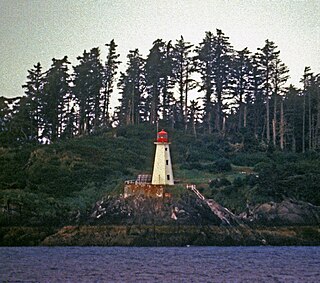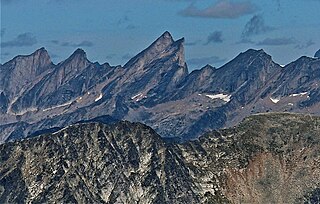
Kaien Island is a Canadian island on the coast of British Columbia, just north of the mouth of the Skeena River and to the south of the Alaska Panhandle. The island has an area of about 45 square kilometres, is roughly oval, and about 11 kilometres (6.8 mi) long along its long axis. The island consists of a central mountain ridge, surrounded by coastal lowlands, the dominant central peak is Mount Hays reaching 708 metres (2,323 ft), with a secondary peak, Mount Olfield reaching 555 metres (1,821 ft) to the northeast.

The Columbia Mountains are a group of mountain ranges along the Upper Columbia River in British Columbia, Montana, Idaho and Washington. The mountain range covers 135,952 km². The range is bounded by the Rocky Mountain Trench on the east, and the Kootenai River on the south; their western boundary is the edge of the Interior Plateau. Seventy-five percent of the range is located in Canada and the remaining twenty-five percent in the United States; American geographic classifications place the Columbia Mountains as part of the Rocky Mountains complex, but this designation does not apply in Canada. Mount Sir Sandford is the highest mountain in the range, reaching 3,519 metres (11,545 ft).

Parts of this article have been adapted from the BC Parks website.
Khutzeeymateen Provincial Park, also known as Khutzeymateen/K'tzim-A-Deen Grizzly Sanctuary, is a Class A provincial park located in the North Coast region of British Columbia, Canada. The park, within the purview of BC Parks, was established on August 15, 1994, to protect critical habitat for the region's grizzly bear population and the largest contiguous stand of old-growth Sitka spruce in the world. It was officially opened by Prince Philip, Duke of Edinburgh, on August 17, 1994.

Mount Maxwell Provincial Park is a provincial park in the Gulf Islands of British Columbia, Canada. It is located on Burgoyne Bay and the Sansum Narrows on the western shores of Saltspring Island.

The Purcell Wilderness Conservancy is a provincial park in British Columbia, Canada. It was established in 1974, and encompasses six large drainages in the Purcell Mountains in the southeast of the province. It contains high peaks, alpine meadows and ridges, deep creek and river valleys, and hot springs at Dewar Creek.

Kennedy Lake is the largest lake on Vancouver Island, British Columbia, Canada. Located north of Ucluelet on the island's central west coast, the lake is formed chiefly by the confluence of the Clayoquot and Kennedy Rivers. Outflow is via a short stretch of the Kennedy River into Tofino Inlet. The lake includes an extensive northern arm called Clayoquot Arm.

Pitt Island is an island located on the north coast of British Columbia, Canada.

Naikoon Provincial Park is a provincial park on northeastern Graham Island in the Haida Gwaii archipelago, British Columbia, Canada. It is the ancestral home of the Gwak'rala'chala people, one of the many tribes that form the native group Haida. While it is a popular destination for adventurous campers, it is also very secluded, being over 16 km (9.9 mi) away from Masset.

Campania Island is an island on the coast of the Canadian province of British Columbia. It is located south of Prince Rupert, east across Hecate Strait from Haida Gwaii. To its west, across Estevan Sound, is the Estevan Group archipelago. Banks Island lies to the northwest, across Nepean Sound; and Pitt Island to the north, across Otter Channel. To the northeast, across Squally Channel, is Gil Island, and to the east is Princess Royal Island, across Campania Sound. To the south of Campania Island is Caamaño Sound, beyond which is Aristazabal Island.

Calvert Island is an island on the coast of the Canadian province of British Columbia. It is east of Queen Charlotte Sound in the Central Coast region, about 100 kilometres (62 mi) north of the town of Port Hardy, which is at the north end of Vancouver Island.
Hunter Island is an island on the coast of the Canadian province of British Columbia. It is located inshore from Queen Charlotte Sound, about 130 kilometres (81 mi) north of the town of Port Hardy at the north end of Vancouver Island.

Dunn Peak is a group of peaks in the central Interior of British Columbia, Canada. Its most prominent summit, Matterhorn Peak, rises to 2,636 metres (8,648 ft), making it the highest point in the Shuswap Highland.

The Lucy Islands are a small archipelago off the North Coast of the province of British Columbia in Canada. The low-lying and heavily forested group, named after its largest island, Lucy Island, constitutes a provincially protected conservancy area that contains some of the North Coast’s oldest archeological sites, a nationally significant seabird population, and a prominent 20th-century lighthouse.

Truce Mountain is a 3,262-metre (10,702-foot) glaciated mountain summit located in the Purcell Mountains of British Columbia, Canada. It is situated 46 km (29 mi) north of Kaslo, on the northern boundary of Purcell Wilderness Conservancy Provincial Park and Protected Area. The nearest higher peak is Mount Hamill, 11 km (6.8 mi) to the southeast. Other nearby peaks include Mount Macbeth, 11 km (6.8 mi) to the northwest, and Archduke Mountain, 6 km (3.7 mi) to the west. The first ascent of Truce Mountain was made August 9, 1916, by Conrad Kain, H. Otto Frind, Elise Hopkins, Albert H. MacCarthy, Elizabeth MacCarthy, Margaret Stone, Winthrop E. Stone, Mrs. George E. Vincent, and John Vincent. The mountain's name was officially adopted June 9, 1960, when approved by the Geographical Names Board of Canada.

Redtop Mountain is a 3,156-metre (10,354-foot) mountain summit located in the Purcell Mountains of British Columbia, Canada. It is situated 44 km (27 mi) southwest of Invermere, and 49 km (30 mi) north-northeast of Kaslo, on the northern boundary of Purcell Wilderness Conservancy Provincial Park and Protected Area. Nearby peaks include Truce Mountain, 10 km (6.2 mi) to the west, Mount Earl Grey, 1.5 km (0.93 mi) to the northeast, and Jumbo Mountain, 10 km (6.2 mi) to the north. The first ascent of Redtop Mountain was made August 11, 1916, by Albert H. MacCarthy, Elizabeth MacCarthy, and Conrad Kain. Albert MacCarthy would go on to lead the 1925 first ascent of Mount Logan, Canada's highest mountain. The mountain's name was officially adopted June 9, 1960, when approved by the Geographical Names Board of Canada.

The Burdwood Group Conservancy is a conservancy located in the Broughton Archipelago in Mount Waddington Regional District, British Columbia. It was established by BC Parks on 13 March 2009 to protect a unique cluster of forested islands and islets situated at the entrance to Tribune Channel.
Duu Guusd Heritage Site/Conservancy is a heritage site and conservancy located in the northwest corner of Graham Island in the Haida Gwaii archipelago of British Columbia, Canada. It was established on March 23, 2008 to protect the ecological integrity and cultural importance of the region. The conservancy is part of an archipelago-wide system of protected areas that includes Gwaii Haanas National Park Reserve and Haida Heritage Site, Gwaii Haanas National Marine Conservation Area Reserve and Haida Heritage Site, and 17 other provincially protected areas.
The Ecstall River is a tributary of the Skeena River in the province of British Columbia, Canada. It originates in the Kitimat Ranges, and flows about 110 km (68 mi) to the lower tidal reach of the Skeena River at Port Essington, about 30 km (19 mi) southeast of Prince Rupert, 95 km (59 mi) southwest of Terrace, and 85 km (53 mi) northwest of Kitimat. Its drainage basin covers about 1,485 km2 (573 sq mi) and contains the largest blocks of unlogged land on the north coast of British Columbia, although large-scale industrial logging operations, both active and proposed, have been occurring in the watershed since the 1980s.

Hall Peak is a 3,048-metre (10,000-foot) mountain summit located in British Columbia, Canada.

















